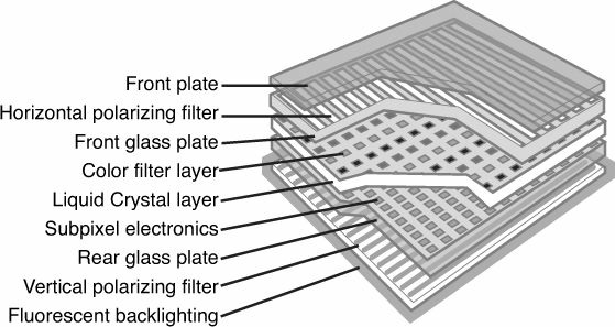Hardware Reference
In-Depth Information
Figure 12.23. A typical color LCD display.
Active-Matrix Displays
LCD panels use a type of active-matrix technology known as a
thin-film transistor (TFT)
array. TFT
is a method for packaging from one (monochrome) to three (RGB color) transistors per pixel within a
flexible material that is the same size and shape as the display. Thus, the transistors for each pixel lie
directly behind the liquid crystal cells they control.
Two TFT manufacturing processes account for most of the active-matrix displays on the market
today: hydrogenated amorphous silicon (a-Si) and low-temperature polysilicon (p-Si). These
processes differ primarily in their costs. At first, most TFT displays were manufactured using the a-Si
process because it required lower temperatures (less than 400°C) than the p-Si process of the time.
Now, lower-temperature p-Si manufacturing processes are making this method an economically
viable alternative to a-Si.
To improve horizontal viewing angles in the latest LCDs, some vendors have modified the classic
TFT design. For example, Hitachi's in-plane switching (IPS) design—also known as STFT—aligns
the individual cells of the LCD parallel to the glass, running the electric current through the sides of
the cells and spinning the pixels to provide more even distribution of the image to the entire panel
area. Hitachi's Super-IPS technology also rearranges the liquid crystal molecules into a zigzag
pattern, rather than the typical row-column arrangement, to reduce color shift and improve color
uniformity. The similar multidomain vertical alignment (MVA) technology developed by Fujitsu
divides the screen into different regions and changes the angle of the regions.
Both Super-IPS and MVA provide a wider viewing angle than traditional TFT displays. Other
companies have different names for the same technology—for example, Sharp calls it Ultra High
Aperture (UHA). Manufacturers often like to think up their own buzzwords for the same technology
because it makes their products seem different, but the results they generate are largely the same.
Because larger LCDs can exhibit shifts in viewing angle even for an individual user, these more
advanced technologies are often used on larger and more expensive panels.
Benefits of LCD Panels
LCD monitors offer a number of benefits when compared to conventional CRT glass tube monitors.
Because LCDs use direct addressing of the display (each pixel in the picture corresponds with a

